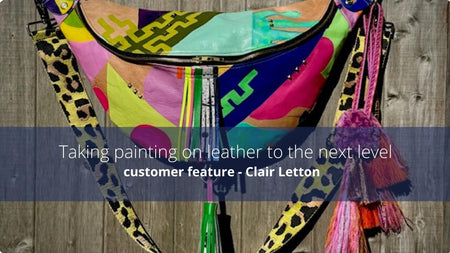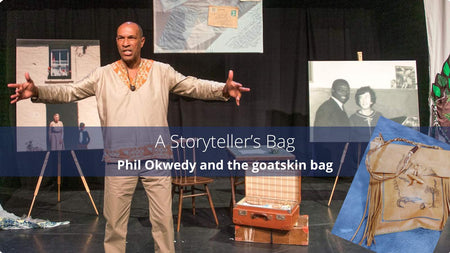The remarkable story of sunken Russian Leather...
Short Story
On December 10th 1786 a storm forced the Metta Catharina to seek shelter in Plymouth Sound. She had been bound for the Mediterranean with a cargo of hemp and leather from the Russian Port of St. Petersburg. The crew were able to get ashore but the ship and its cargo were lost - until almost 200 years later divers found a ship’s bell on the sea floor.
Further investigation revealed bundles of hides littering the sea bed. They were remarkably well preserved after two centuries of immersion in black mud.
Since those hides were retrieved, many hundreds have been brought to the surface. They have been tanned the traditional Russian way, which involves soaking in pits of willow bark and currying with birch oil. The process gives them a very distinct aroma. Most of the hides have been cross hatched in the grain embossed by hand.
The famous ‘Russia’ leather is renowned for it’s ability to resist water and repel insects.
Reproduction Russian Leather from The Identity Store

The hides we have at The Identity Store have had available are a faithful re-production of the Metta Catharina hides, tanned with oak bark and birch oil and given the characteristic surface grain pattern.
Suitable for: Bags, clutches, purses, wallet interiors and exteriors, watch-straps, shoes, pouches, tool rolls and other small leather goods


Leathergoods made by Robert Ross from the Orginal Metta Catharina leather.
Working with Reproduction Russian Leather
This leather will work in much the same way as our other vegetable tanned leathers. Use a sharp knife or leather shears to cut your templates out with and give a nice clean edge to work with.
Edge Finishing – as a fine leather it is best edge treated with the Identity Leading Edge Treatment (see our website for details). Keep a clean sharp edge by making sure you strop your knife before cutting. Use Edge Foundation to give a smoothing effect and to act as a primer for the coloured edge treatments.
Wet Moulding/Hardening– this leather can be wet moulded to create sculptural detail for your projects. For best result drop into hot water, shape and leave to dry near to heat source, or placed for a maximum of five minutes in a low oven at no more than 50 degrees for a harder outcome.
Finishing – due to the oils used in the tannage very little if any finish is needed, a gentle light rub over with Carnauba Cream or Ducks Wax and buff to a soft sheen would be sufficient. Approx 0.9-1.1mm Suitable for bag making, purses, pouches, phone cases, wallets, laptop/gadget covers, watch straps, shoes, and small leather goods Colour – a rich shade of mahogany brown.
The Longer Story...
In the autumn of 1786, Captain Twedt commanded the Die Frau Metta Catherina, a 53-ton brigantine bound from St. Petersburg to Genoa carrying a cargo of hemp and leather. Captain Twedt anchored the brigantine in the shelter of Plymouth Sound. That is as far as the ship got. The winds unexpectedly shifted, a full-scale gale screamed into Plymouth Sound, and the previously safe anchorage turned deadly. The storm had torn Die Frau Metta Catherina from her anchorage, and she sank to a depth of about 100 feet on the Cornish side of Plymouth Sound. For almost two centuries Captain Twedt's vessel was just another silt-covered statistic at Lloyds in London, until until she was discovered by members of a local diving club in 1973.
Their initial findings included a ship's bell. When it was brought to the surface and cleaned, it read: ''Die Frau Meta Catherina von Flensburg 1782 Die Brigantine.'' With the ship's name, place of origin and date of construction reliably established, interest quickened. As the divers continued to investigate, they found and brought to the surface bundles that proved to contain hides of Russia leather.
The amount of usable leather in the find has still not been determined. ''The hides on the outer edges of the rolls, as well as others that were disturbed as the vessel sank, had all deteriorated badly,'' Mr. Brown said. ''The inner hides in most of the rolls were in a remarkable state of preservation, protected by the layers of thick mud that covered everything.''
Scientific scrutiny showed the hides were possibly reindeer* (see comment s section below) and that they had been treated in the classic methods typical of Russia leather.
In its time Russia leather was a top-of-the-line luxury, whose manufacturing secrets Western Europeans and Americans couldn't crack. The St. Petersburg artisans used willow bark to tan the hides, curried them with birch oil and embossed a crosshatched grain on them by hand.
The birch oil gives these hides -- even today -- a characteristic aroma, while the cross-hatching is the accepted visual trademark of Russia leather. In the 18th century, Russian leather was widely considered to be the finest in the world. It was known for being incredibly rich in colour, supple, and water resistant. There was also something about its aroma that allowed it to repel insects. It was truly unique.
Tanneries in Western Europe tried to duplicate Russia’s distinctive, beautiful, and hardwearing leather. They even sent spies to try to uncover trade secrets. Unfortunately, very little became known. What they did find out, however, was that the pre-tanning stages alone took up to six months.
During the tanning stage, the hides, soaking in previously-used tanning fluid, were more or less continuously turned by hand for about four months. Then they were transferred to pits where they soaked in water mixed with bark from willows, poplar, oak, and larch trees for about eighteen months. After that, they were cured, dried, beaten with mallets, pared with shaving knives, and then pulled over sharp-edged rings, which cut them with the fine cross-hatched scores they were known for.
Once the wreck was discovered, littered around the seabed of the broken ship, the divers found bundles and bundles of hides. They brought the bundles up to surface, and when they untied them, the packages opened up like packs of vacuum-sealed coffee. Apparently, the hides’ immersion in black mud, combined with their mysterious oils, allowed them to go nearly 200 years with very little water penetrating.
At first, the divers didn’t even know what they found. They went to a bar the next night and casually talked about it. A young leather worker, Robin Snelson, overheard and asked if he could see the hides. Snelson developed a cleaning technique to help restore the hides to their original quality. Once cleaned, they beamed with rich colours, varying from deep claret to lighter sienna. They also revealed their cross-hatched surface, and began giving away their distinct sweet aroma. There was no other leather with this aroma, and it was clear these were the famed Russian leathers that was once only a historical legend.

Image: Russian Leather – putthison.com
Nobody knows how many hides are left buried in that wreck. Recovery has not been easy, and the job is incredibly dangerous. The bundles near the bows and stern have been cleared out, for the most part, but some believe there may be more in some of the unexplored areas. However, those areas are too dangerous to approach, and nobody has been willing to risk their lives for the additional hides.
 Image – Worthpoint.com/worthopedia
Image – Worthpoint.com/worthopedia
Sources:
http://www.shipsproject.org/Wrecks/Wk_Catharina.html
Furher Reading - purchase the book - https://www.greatenglish.co.uk/product/shipwreck-the-loss-of-the-metta-catharina-in-1786/
https://www.nytimes.com/2002/04/28/nyregion/a-200-year-old-gift-from-under-the-sea.html










I have a large amount of this leather including key fobs wallets belts dog collars the only ones ever made. And a doctors bag all unused with certificates of authenticity anyone interested call 07811164926
Your using a image of mine without permission and without credit. Also have not responded to two contacts. Do the right thing
Hello.
I have a shirt wallet(nowadays called a credit card wallet) that I had made by a leather worker who had a shop in Falmouth high street in late 70s early 80s can’t remember his name but lt still looks great.
I had a key ring made from this leather that was bought in the 1980s in a leather shop in Penryn, Cornwall. I’m trying to find a replacement
I had a key ring made from this leather that was bought in the 1980s in a leather shop in Penryn, Cornwall. I’m trying to find a replacement